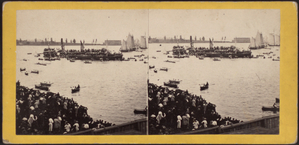The Fourth of July is this Sunday, and you're probably excited to relax by the pool, be with family and friends, and watch fireworks light up the night sky. I, on the other hand, have been immersed in Tenement Museum World for the last month. I couldn't help but wonder how nineteenth and early twentieth century tenement dwellers and recent immigrants would have celebrated the country’s Independence Day. Everyday life was tough for the working class, from working long hours to overcoming diseases. Would these obstacles have stymied a celebration of our nation’s holiday?
New York's Union Square on July 4, 1876. Collection of the New York Public Library.
After careful research, I found documents that explained how the tenement dwellers may have celebrated the Fourth of July.
One intriguing artifact was the “Souvenir Program, July 4, 1912, East Side Celebration, City of New York” by the East Side General Committee. The introduction to the souvenir program says that in 1911 (when over 10,000 marched in the parade) Mayor Gaynor first invited the East Side, through the Central Committee, to take part in the celebration of the Fourth of July. According to the pamphlet, “the East Side was aflame with patriotism.”
From a New York Times article on July 5, 1912, I gathered that the East Side General Committee might have received direction from “the Mayor’s Fourth of July Committee for the patriotic expression of New York” when drafting their ceremonies. Apparently the mayor had written one essay about having a safe and sane Fourth of July that was supposed to be read at all the ceremonies occurring all over the city.
The pamphlet also reflected on the difficulties of tenement and immigrant life. It read, “We to-day are proud to point to the large and powerful labor movement of the East Side, consisting of brave men and women who have suffered and starved for an American standard of living.” Even though they probably felt conflicting emotions, between missing the old country and trying to create a better life in the new, they took the Fourth of July as a day to celebrate their hard work.
From the activities listed on the itinerary, there appears to have been a strong sense of pride on the Lower East Side. There were morning, afternoon and evening celebrations at several different locations in the area. Beginning at “9:30 am sharp” there were celebrations at both Seward Park (at Essex Street and East Broadway) and Hamilton Fish Park (at Stanton and Pitt Streets). The afternoon celebrations took place at various New York public schools on the Lower East Side, and the evening festivities ended at the morning locales.
I wondered about the likelihood of tenement dwellers participating if the activities were in English and they were not fluent speakers. East Siders solved this problem by making many aspects bilingual. At PS 91 at Stanton and Forsyth Streets, the Declaration of Independence was recited in both English and Yiddish. Similarly, at the People’s Theatre at Bowery and Rivington Streets, participants read essays in both Hebrew and English. Included in the program was the Jewish community’s unique pledge to the American flag, written in English and Hebrew. It was a reflection on their ancestors’ oppressed past and a promise to uphold the United States’ ideals of freedom and liberty.
A boat race in New York City on July 4, 1860
The New York Times reported on July 5, 1912 about the celebrations on the Lower East Side. One reporter wrote, “It was evident that it was an event in the lives of the dwellers in the crowded tenement districts and in Rutgers and Mulberry Bend Parks on the lower east side…it was hardly possible to move about at all. But perhaps the prettiest display of all was given right in front of the Settlement House. There Arthur Williams of the New York Edison Company had, at its own expense, erected strings of lights from side to side of the street and the Settlement workers had provided a programme of folk dancing by the girls of the neighborhood. Part of the street had been roped off for the event, and every window of the tenement houses on each side of the street was used as a grand stand to see the dances.” The Henry Street Settlement was established in 1893 as a provider of social services and arts programming.
Two years prior, the New York Times reported on the quietness and lack of casualties and injuries on July 4, 1910 and focused on the success of the city’s parade. (Read tomorrow about the dangers of fireworks in New York City!) The parade route wound from 23rd Street and Fifth Avenue down to City Hall Park. According to Hopstop.com, the walking would have taken 42 minutes. As the map shows, at least the end portion of the parade would have been accessible for Lower East Siders.
Be sure to read tomorrow’s blog about the history of fireworks in New York City!
-posted by Devin, with thanks to Mary Brown, Dave Favaloro, the Dorot Jewish Division of the New York Public Library and the New York Public Library Digital Gallery





Very interesting! My grandmother was born on Pitt Street in 1912. I wonder if her family attended the 4th of July festivities at Hamilton Fish Park!
ReplyDelete